Hand Washing under Acute Care Settings | Report
VerifiedAdded on 2022/08/31
|13
|2986
|17
AI Summary
Contribute Materials
Your contribution can guide someone’s learning journey. Share your
documents today.
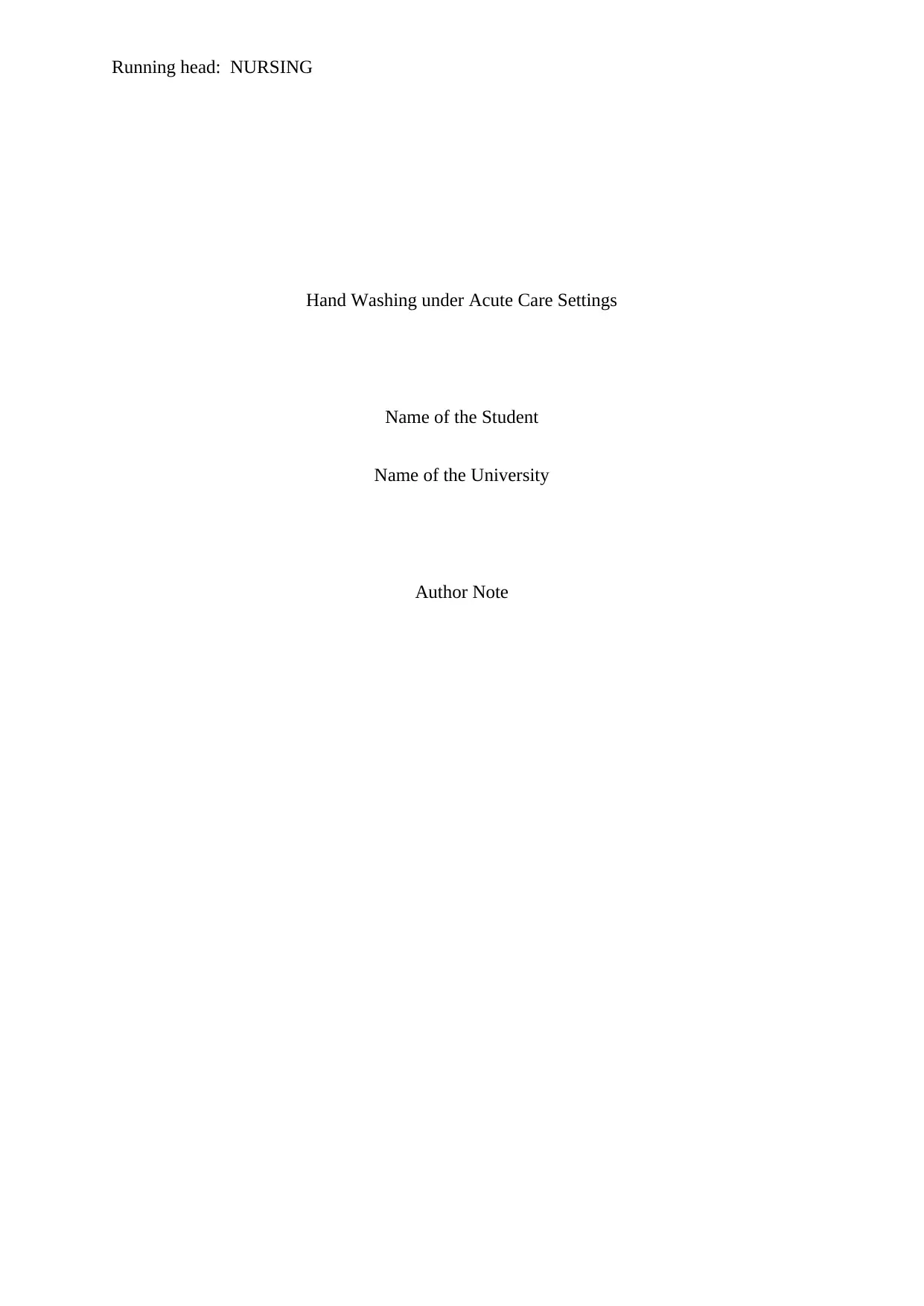
Running head: NURSING
Hand Washing under Acute Care Settings
Name of the Student
Name of the University
Author Note
Hand Washing under Acute Care Settings
Name of the Student
Name of the University
Author Note
Secure Best Marks with AI Grader
Need help grading? Try our AI Grader for instant feedback on your assignments.
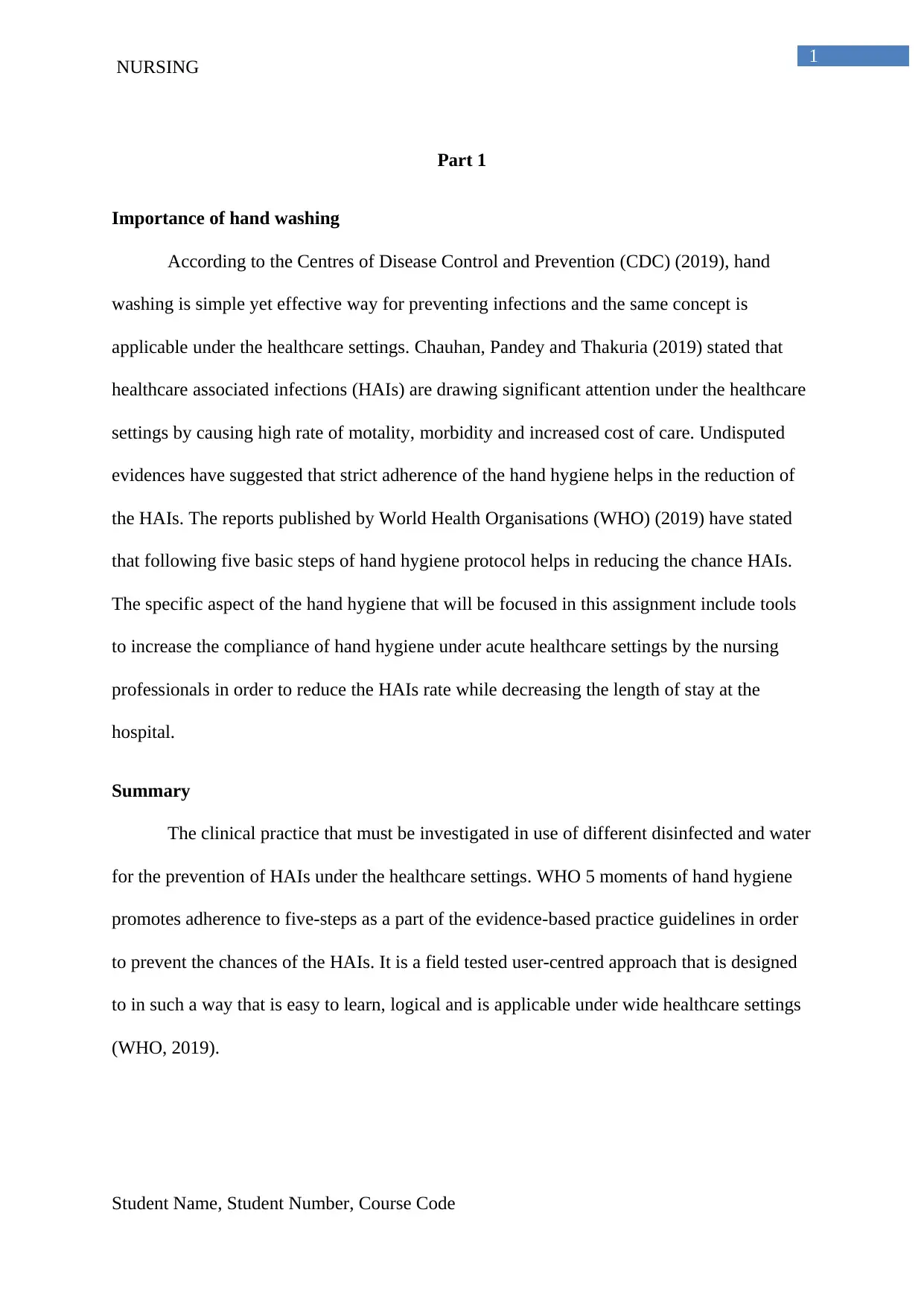
1
NURSING
Part 1
Importance of hand washing
According to the Centres of Disease Control and Prevention (CDC) (2019), hand
washing is simple yet effective way for preventing infections and the same concept is
applicable under the healthcare settings. Chauhan, Pandey and Thakuria (2019) stated that
healthcare associated infections (HAIs) are drawing significant attention under the healthcare
settings by causing high rate of motality, morbidity and increased cost of care. Undisputed
evidences have suggested that strict adherence of the hand hygiene helps in the reduction of
the HAIs. The reports published by World Health Organisations (WHO) (2019) have stated
that following five basic steps of hand hygiene protocol helps in reducing the chance HAIs.
The specific aspect of the hand hygiene that will be focused in this assignment include tools
to increase the compliance of hand hygiene under acute healthcare settings by the nursing
professionals in order to reduce the HAIs rate while decreasing the length of stay at the
hospital.
Summary
The clinical practice that must be investigated in use of different disinfected and water
for the prevention of HAIs under the healthcare settings. WHO 5 moments of hand hygiene
promotes adherence to five-steps as a part of the evidence-based practice guidelines in order
to prevent the chances of the HAIs. It is a field tested user-centred approach that is designed
to in such a way that is easy to learn, logical and is applicable under wide healthcare settings
(WHO, 2019).
Student Name, Student Number, Course Code
NURSING
Part 1
Importance of hand washing
According to the Centres of Disease Control and Prevention (CDC) (2019), hand
washing is simple yet effective way for preventing infections and the same concept is
applicable under the healthcare settings. Chauhan, Pandey and Thakuria (2019) stated that
healthcare associated infections (HAIs) are drawing significant attention under the healthcare
settings by causing high rate of motality, morbidity and increased cost of care. Undisputed
evidences have suggested that strict adherence of the hand hygiene helps in the reduction of
the HAIs. The reports published by World Health Organisations (WHO) (2019) have stated
that following five basic steps of hand hygiene protocol helps in reducing the chance HAIs.
The specific aspect of the hand hygiene that will be focused in this assignment include tools
to increase the compliance of hand hygiene under acute healthcare settings by the nursing
professionals in order to reduce the HAIs rate while decreasing the length of stay at the
hospital.
Summary
The clinical practice that must be investigated in use of different disinfected and water
for the prevention of HAIs under the healthcare settings. WHO 5 moments of hand hygiene
promotes adherence to five-steps as a part of the evidence-based practice guidelines in order
to prevent the chances of the HAIs. It is a field tested user-centred approach that is designed
to in such a way that is easy to learn, logical and is applicable under wide healthcare settings
(WHO, 2019).
Student Name, Student Number, Course Code
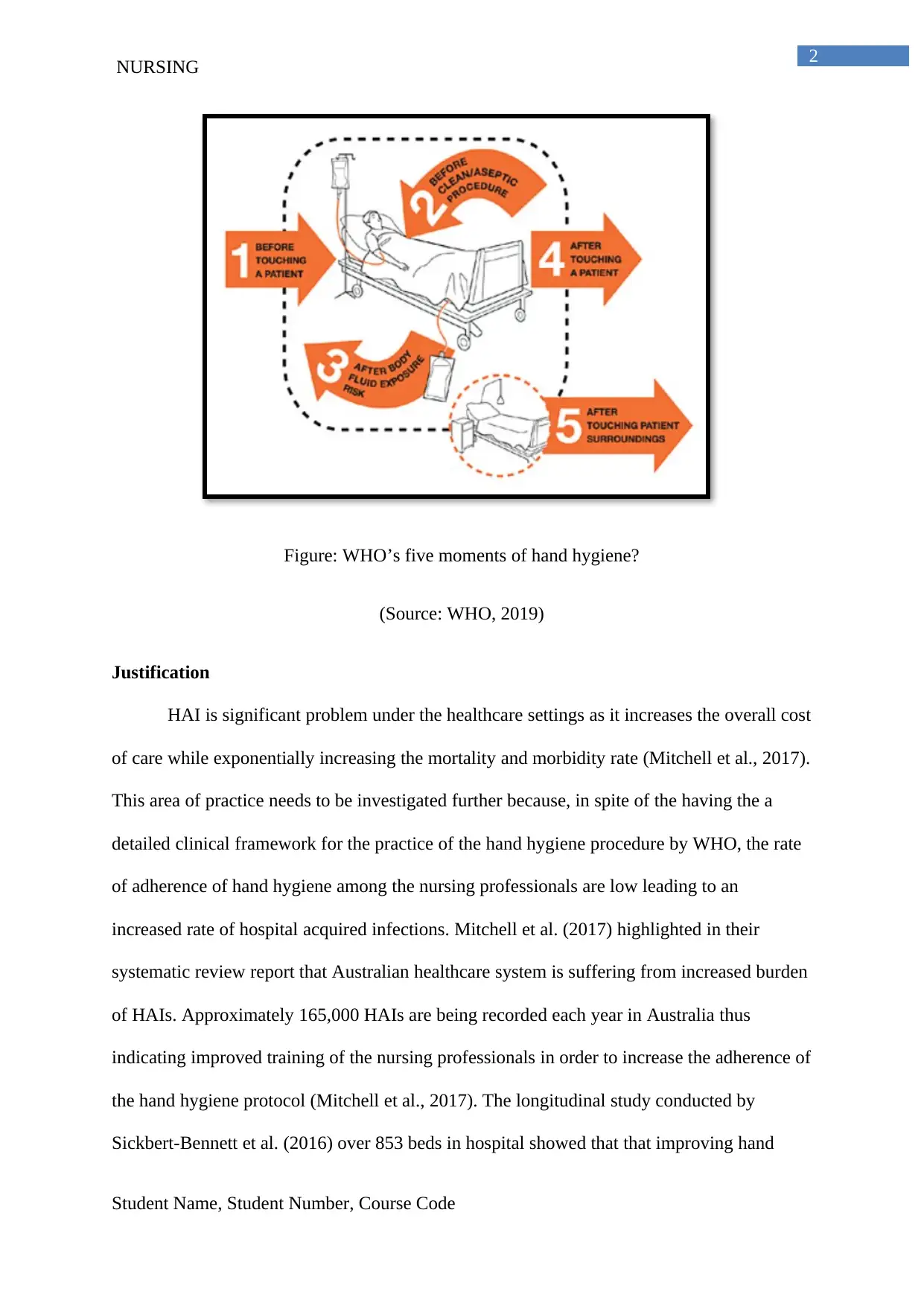
2
NURSING
Figure: WHO’s five moments of hand hygiene?
(Source: WHO, 2019)
Justification
HAI is significant problem under the healthcare settings as it increases the overall cost
of care while exponentially increasing the mortality and morbidity rate (Mitchell et al., 2017).
This area of practice needs to be investigated further because, in spite of the having the a
detailed clinical framework for the practice of the hand hygiene procedure by WHO, the rate
of adherence of hand hygiene among the nursing professionals are low leading to an
increased rate of hospital acquired infections. Mitchell et al. (2017) highlighted in their
systematic review report that Australian healthcare system is suffering from increased burden
of HAIs. Approximately 165,000 HAIs are being recorded each year in Australia thus
indicating improved training of the nursing professionals in order to increase the adherence of
the hand hygiene protocol (Mitchell et al., 2017). The longitudinal study conducted by
Sickbert-Bennett et al. (2016) over 853 beds in hospital showed that that improving hand
Student Name, Student Number, Course Code
NURSING
Figure: WHO’s five moments of hand hygiene?
(Source: WHO, 2019)
Justification
HAI is significant problem under the healthcare settings as it increases the overall cost
of care while exponentially increasing the mortality and morbidity rate (Mitchell et al., 2017).
This area of practice needs to be investigated further because, in spite of the having the a
detailed clinical framework for the practice of the hand hygiene procedure by WHO, the rate
of adherence of hand hygiene among the nursing professionals are low leading to an
increased rate of hospital acquired infections. Mitchell et al. (2017) highlighted in their
systematic review report that Australian healthcare system is suffering from increased burden
of HAIs. Approximately 165,000 HAIs are being recorded each year in Australia thus
indicating improved training of the nursing professionals in order to increase the adherence of
the hand hygiene protocol (Mitchell et al., 2017). The longitudinal study conducted by
Sickbert-Bennett et al. (2016) over 853 beds in hospital showed that that improving hand
Student Name, Student Number, Course Code
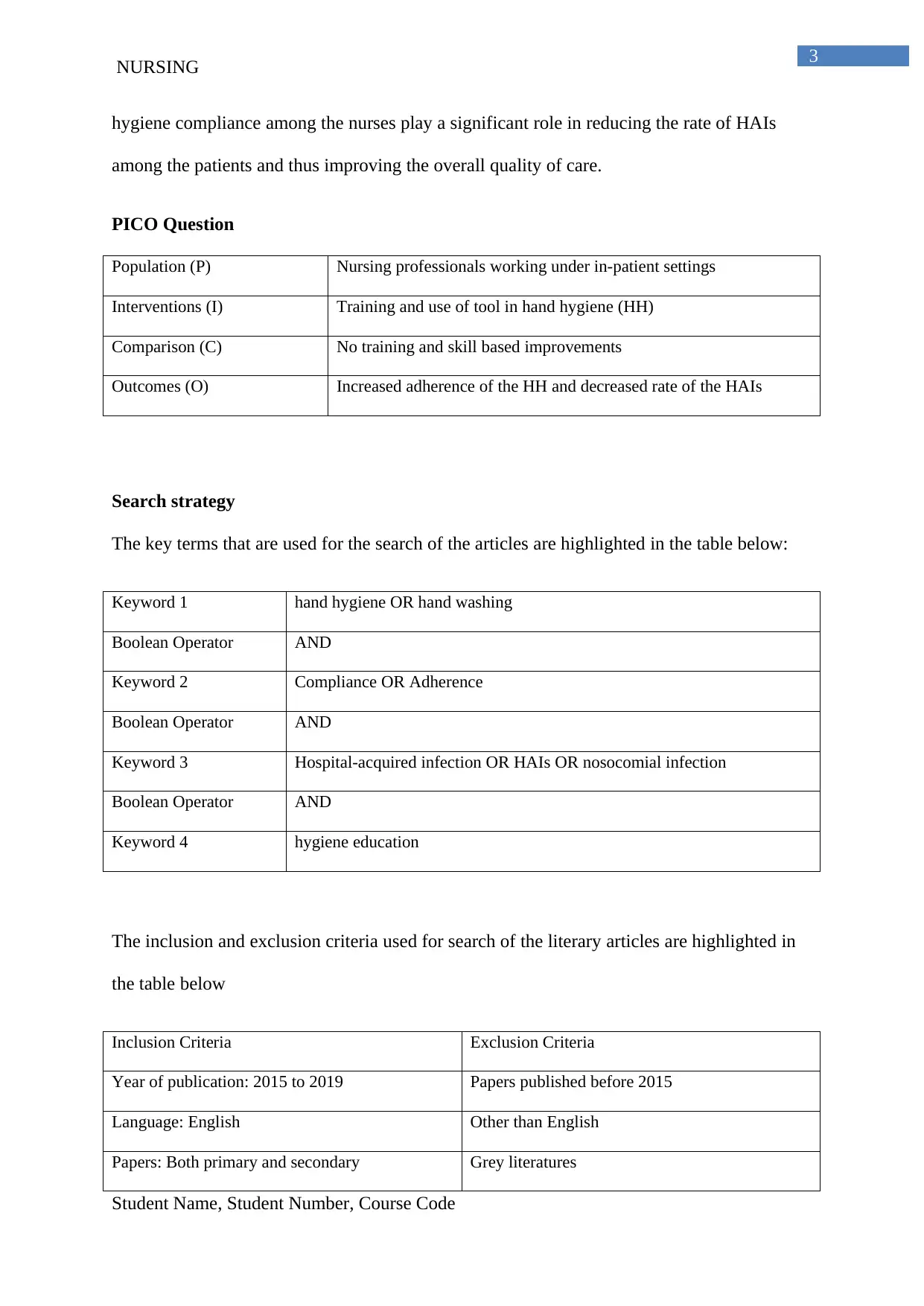
3
NURSING
hygiene compliance among the nurses play a significant role in reducing the rate of HAIs
among the patients and thus improving the overall quality of care.
PICO Question
Population (P) Nursing professionals working under in-patient settings
Interventions (I) Training and use of tool in hand hygiene (HH)
Comparison (C) No training and skill based improvements
Outcomes (O) Increased adherence of the HH and decreased rate of the HAIs
Search strategy
The key terms that are used for the search of the articles are highlighted in the table below:
Keyword 1 hand hygiene OR hand washing
Boolean Operator AND
Keyword 2 Compliance OR Adherence
Boolean Operator AND
Keyword 3 Hospital-acquired infection OR HAIs OR nosocomial infection
Boolean Operator AND
Keyword 4 hygiene education
The inclusion and exclusion criteria used for search of the literary articles are highlighted in
the table below
Inclusion Criteria Exclusion Criteria
Year of publication: 2015 to 2019 Papers published before 2015
Language: English Other than English
Papers: Both primary and secondary Grey literatures
Student Name, Student Number, Course Code
NURSING
hygiene compliance among the nurses play a significant role in reducing the rate of HAIs
among the patients and thus improving the overall quality of care.
PICO Question
Population (P) Nursing professionals working under in-patient settings
Interventions (I) Training and use of tool in hand hygiene (HH)
Comparison (C) No training and skill based improvements
Outcomes (O) Increased adherence of the HH and decreased rate of the HAIs
Search strategy
The key terms that are used for the search of the articles are highlighted in the table below:
Keyword 1 hand hygiene OR hand washing
Boolean Operator AND
Keyword 2 Compliance OR Adherence
Boolean Operator AND
Keyword 3 Hospital-acquired infection OR HAIs OR nosocomial infection
Boolean Operator AND
Keyword 4 hygiene education
The inclusion and exclusion criteria used for search of the literary articles are highlighted in
the table below
Inclusion Criteria Exclusion Criteria
Year of publication: 2015 to 2019 Papers published before 2015
Language: English Other than English
Papers: Both primary and secondary Grey literatures
Student Name, Student Number, Course Code
Secure Best Marks with AI Grader
Need help grading? Try our AI Grader for instant feedback on your assignments.
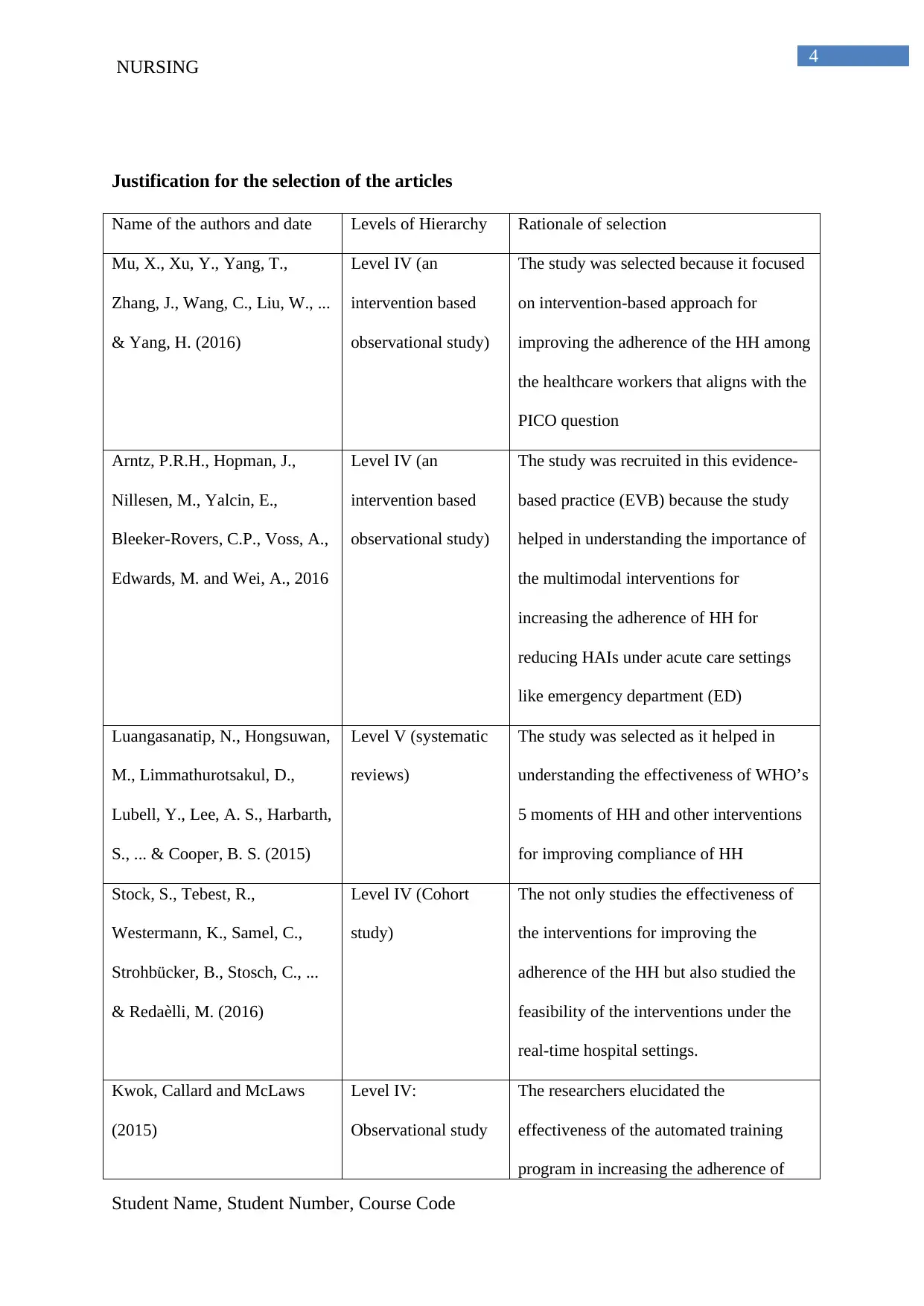
4
NURSING
Justification for the selection of the articles
Name of the authors and date Levels of Hierarchy Rationale of selection
Mu, X., Xu, Y., Yang, T.,
Zhang, J., Wang, C., Liu, W., ...
& Yang, H. (2016)
Level IV (an
intervention based
observational study)
The study was selected because it focused
on intervention-based approach for
improving the adherence of the HH among
the healthcare workers that aligns with the
PICO question
Arntz, P.R.H., Hopman, J.,
Nillesen, M., Yalcin, E.,
Bleeker-Rovers, C.P., Voss, A.,
Edwards, M. and Wei, A., 2016
Level IV (an
intervention based
observational study)
The study was recruited in this evidence-
based practice (EVB) because the study
helped in understanding the importance of
the multimodal interventions for
increasing the adherence of HH for
reducing HAIs under acute care settings
like emergency department (ED)
Luangasanatip, N., Hongsuwan,
M., Limmathurotsakul, D.,
Lubell, Y., Lee, A. S., Harbarth,
S., ... & Cooper, B. S. (2015)
Level V (systematic
reviews)
The study was selected as it helped in
understanding the effectiveness of WHO’s
5 moments of HH and other interventions
for improving compliance of HH
Stock, S., Tebest, R.,
Westermann, K., Samel, C.,
Strohbücker, B., Stosch, C., ...
& Redaèlli, M. (2016)
Level IV (Cohort
study)
The not only studies the effectiveness of
the interventions for improving the
adherence of the HH but also studied the
feasibility of the interventions under the
real-time hospital settings.
Kwok, Callard and McLaws
(2015)
Level IV:
Observational study
The researchers elucidated the
effectiveness of the automated training
program in increasing the adherence of
Student Name, Student Number, Course Code
NURSING
Justification for the selection of the articles
Name of the authors and date Levels of Hierarchy Rationale of selection
Mu, X., Xu, Y., Yang, T.,
Zhang, J., Wang, C., Liu, W., ...
& Yang, H. (2016)
Level IV (an
intervention based
observational study)
The study was selected because it focused
on intervention-based approach for
improving the adherence of the HH among
the healthcare workers that aligns with the
PICO question
Arntz, P.R.H., Hopman, J.,
Nillesen, M., Yalcin, E.,
Bleeker-Rovers, C.P., Voss, A.,
Edwards, M. and Wei, A., 2016
Level IV (an
intervention based
observational study)
The study was recruited in this evidence-
based practice (EVB) because the study
helped in understanding the importance of
the multimodal interventions for
increasing the adherence of HH for
reducing HAIs under acute care settings
like emergency department (ED)
Luangasanatip, N., Hongsuwan,
M., Limmathurotsakul, D.,
Lubell, Y., Lee, A. S., Harbarth,
S., ... & Cooper, B. S. (2015)
Level V (systematic
reviews)
The study was selected as it helped in
understanding the effectiveness of WHO’s
5 moments of HH and other interventions
for improving compliance of HH
Stock, S., Tebest, R.,
Westermann, K., Samel, C.,
Strohbücker, B., Stosch, C., ...
& Redaèlli, M. (2016)
Level IV (Cohort
study)
The not only studies the effectiveness of
the interventions for improving the
adherence of the HH but also studied the
feasibility of the interventions under the
real-time hospital settings.
Kwok, Callard and McLaws
(2015)
Level IV:
Observational study
The researchers elucidated the
effectiveness of the automated training
program in increasing the adherence of
Student Name, Student Number, Course Code
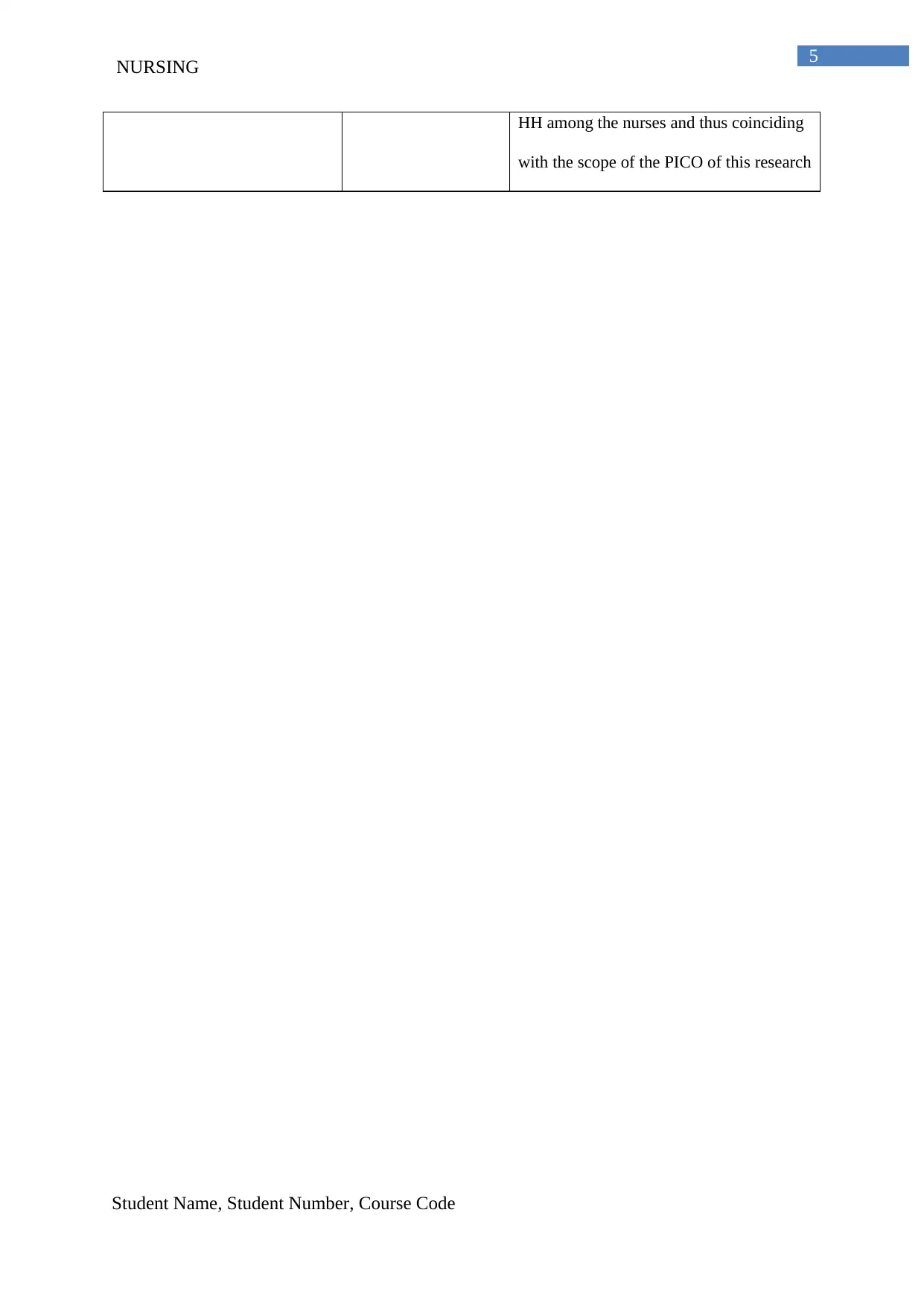
5
NURSING
HH among the nurses and thus coinciding
with the scope of the PICO of this research
Student Name, Student Number, Course Code
NURSING
HH among the nurses and thus coinciding
with the scope of the PICO of this research
Student Name, Student Number, Course Code
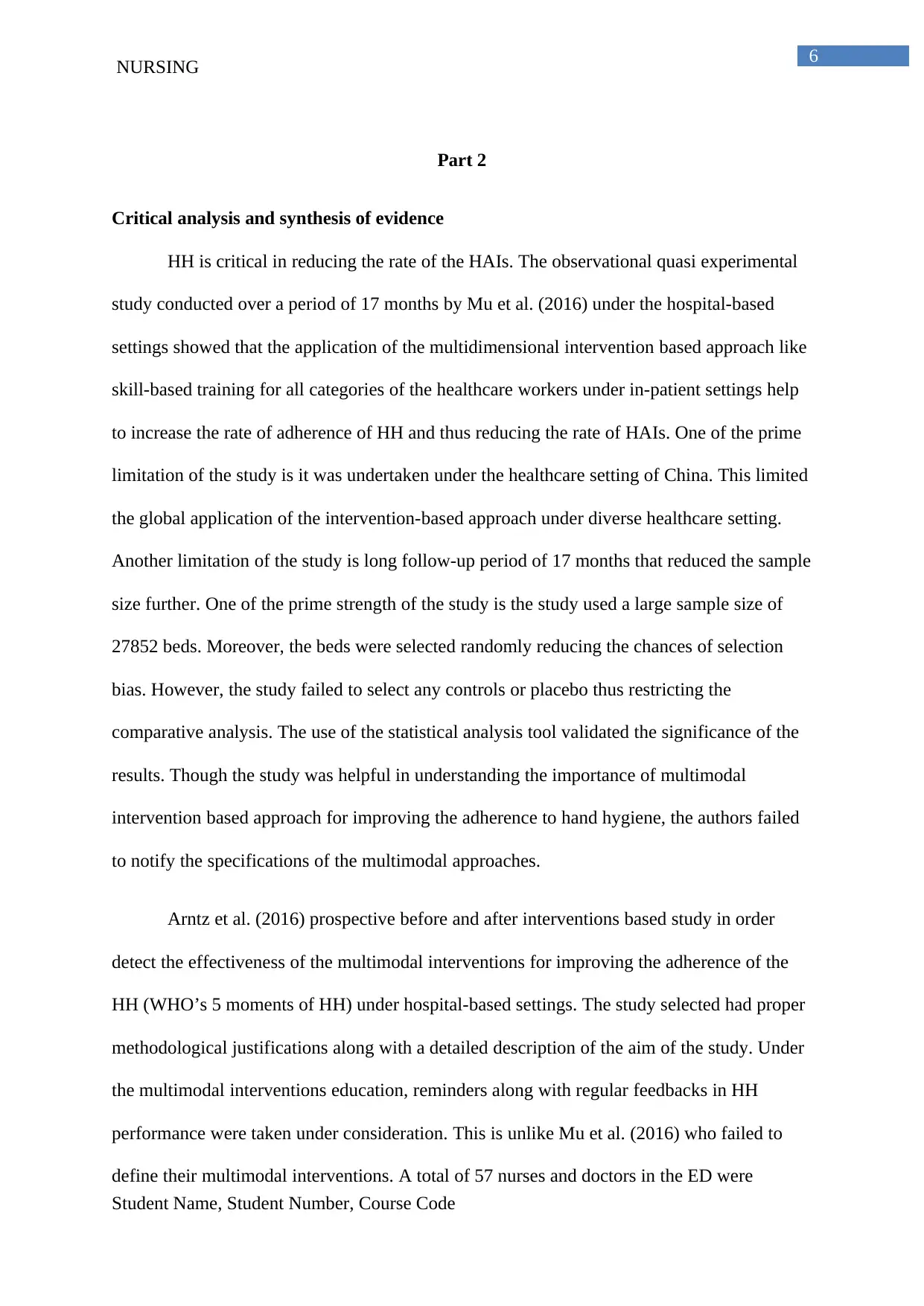
6
NURSING
Part 2
Critical analysis and synthesis of evidence
HH is critical in reducing the rate of the HAIs. The observational quasi experimental
study conducted over a period of 17 months by Mu et al. (2016) under the hospital-based
settings showed that the application of the multidimensional intervention based approach like
skill-based training for all categories of the healthcare workers under in-patient settings help
to increase the rate of adherence of HH and thus reducing the rate of HAIs. One of the prime
limitation of the study is it was undertaken under the healthcare setting of China. This limited
the global application of the intervention-based approach under diverse healthcare setting.
Another limitation of the study is long follow-up period of 17 months that reduced the sample
size further. One of the prime strength of the study is the study used a large sample size of
27852 beds. Moreover, the beds were selected randomly reducing the chances of selection
bias. However, the study failed to select any controls or placebo thus restricting the
comparative analysis. The use of the statistical analysis tool validated the significance of the
results. Though the study was helpful in understanding the importance of multimodal
intervention based approach for improving the adherence to hand hygiene, the authors failed
to notify the specifications of the multimodal approaches.
Arntz et al. (2016) prospective before and after interventions based study in order
detect the effectiveness of the multimodal interventions for improving the adherence of the
HH (WHO’s 5 moments of HH) under hospital-based settings. The study selected had proper
methodological justifications along with a detailed description of the aim of the study. Under
the multimodal interventions education, reminders along with regular feedbacks in HH
performance were taken under consideration. This is unlike Mu et al. (2016) who failed to
define their multimodal interventions. A total of 57 nurses and doctors in the ED were
Student Name, Student Number, Course Code
NURSING
Part 2
Critical analysis and synthesis of evidence
HH is critical in reducing the rate of the HAIs. The observational quasi experimental
study conducted over a period of 17 months by Mu et al. (2016) under the hospital-based
settings showed that the application of the multidimensional intervention based approach like
skill-based training for all categories of the healthcare workers under in-patient settings help
to increase the rate of adherence of HH and thus reducing the rate of HAIs. One of the prime
limitation of the study is it was undertaken under the healthcare setting of China. This limited
the global application of the intervention-based approach under diverse healthcare setting.
Another limitation of the study is long follow-up period of 17 months that reduced the sample
size further. One of the prime strength of the study is the study used a large sample size of
27852 beds. Moreover, the beds were selected randomly reducing the chances of selection
bias. However, the study failed to select any controls or placebo thus restricting the
comparative analysis. The use of the statistical analysis tool validated the significance of the
results. Though the study was helpful in understanding the importance of multimodal
intervention based approach for improving the adherence to hand hygiene, the authors failed
to notify the specifications of the multimodal approaches.
Arntz et al. (2016) prospective before and after interventions based study in order
detect the effectiveness of the multimodal interventions for improving the adherence of the
HH (WHO’s 5 moments of HH) under hospital-based settings. The study selected had proper
methodological justifications along with a detailed description of the aim of the study. Under
the multimodal interventions education, reminders along with regular feedbacks in HH
performance were taken under consideration. This is unlike Mu et al. (2016) who failed to
define their multimodal interventions. A total of 57 nurses and doctors in the ED were
Student Name, Student Number, Course Code
Paraphrase This Document
Need a fresh take? Get an instant paraphrase of this document with our AI Paraphraser
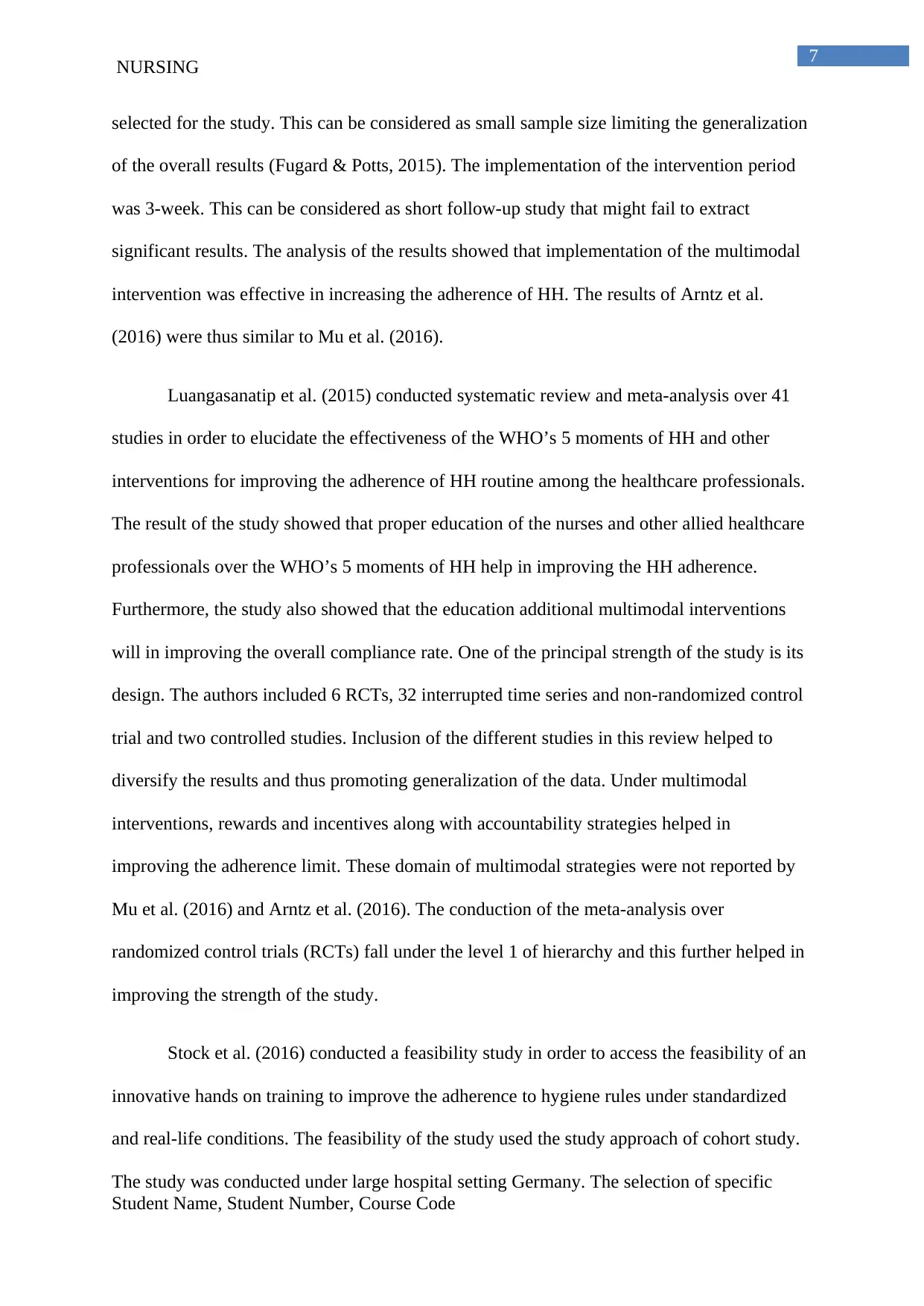
7
NURSING
selected for the study. This can be considered as small sample size limiting the generalization
of the overall results (Fugard & Potts, 2015). The implementation of the intervention period
was 3-week. This can be considered as short follow-up study that might fail to extract
significant results. The analysis of the results showed that implementation of the multimodal
intervention was effective in increasing the adherence of HH. The results of Arntz et al.
(2016) were thus similar to Mu et al. (2016).
Luangasanatip et al. (2015) conducted systematic review and meta-analysis over 41
studies in order to elucidate the effectiveness of the WHO’s 5 moments of HH and other
interventions for improving the adherence of HH routine among the healthcare professionals.
The result of the study showed that proper education of the nurses and other allied healthcare
professionals over the WHO’s 5 moments of HH help in improving the HH adherence.
Furthermore, the study also showed that the education additional multimodal interventions
will in improving the overall compliance rate. One of the principal strength of the study is its
design. The authors included 6 RCTs, 32 interrupted time series and non-randomized control
trial and two controlled studies. Inclusion of the different studies in this review helped to
diversify the results and thus promoting generalization of the data. Under multimodal
interventions, rewards and incentives along with accountability strategies helped in
improving the adherence limit. These domain of multimodal strategies were not reported by
Mu et al. (2016) and Arntz et al. (2016). The conduction of the meta-analysis over
randomized control trials (RCTs) fall under the level 1 of hierarchy and this further helped in
improving the strength of the study.
Stock et al. (2016) conducted a feasibility study in order to access the feasibility of an
innovative hands on training to improve the adherence to hygiene rules under standardized
and real-life conditions. The feasibility of the study used the study approach of cohort study.
The study was conducted under large hospital setting Germany. The selection of specific
Student Name, Student Number, Course Code
NURSING
selected for the study. This can be considered as small sample size limiting the generalization
of the overall results (Fugard & Potts, 2015). The implementation of the intervention period
was 3-week. This can be considered as short follow-up study that might fail to extract
significant results. The analysis of the results showed that implementation of the multimodal
intervention was effective in increasing the adherence of HH. The results of Arntz et al.
(2016) were thus similar to Mu et al. (2016).
Luangasanatip et al. (2015) conducted systematic review and meta-analysis over 41
studies in order to elucidate the effectiveness of the WHO’s 5 moments of HH and other
interventions for improving the adherence of HH routine among the healthcare professionals.
The result of the study showed that proper education of the nurses and other allied healthcare
professionals over the WHO’s 5 moments of HH help in improving the HH adherence.
Furthermore, the study also showed that the education additional multimodal interventions
will in improving the overall compliance rate. One of the principal strength of the study is its
design. The authors included 6 RCTs, 32 interrupted time series and non-randomized control
trial and two controlled studies. Inclusion of the different studies in this review helped to
diversify the results and thus promoting generalization of the data. Under multimodal
interventions, rewards and incentives along with accountability strategies helped in
improving the adherence limit. These domain of multimodal strategies were not reported by
Mu et al. (2016) and Arntz et al. (2016). The conduction of the meta-analysis over
randomized control trials (RCTs) fall under the level 1 of hierarchy and this further helped in
improving the strength of the study.
Stock et al. (2016) conducted a feasibility study in order to access the feasibility of an
innovative hands on training to improve the adherence to hygiene rules under standardized
and real-life conditions. The feasibility of the study used the study approach of cohort study.
The study was conducted under large hospital setting Germany. The selection of specific
Student Name, Student Number, Course Code
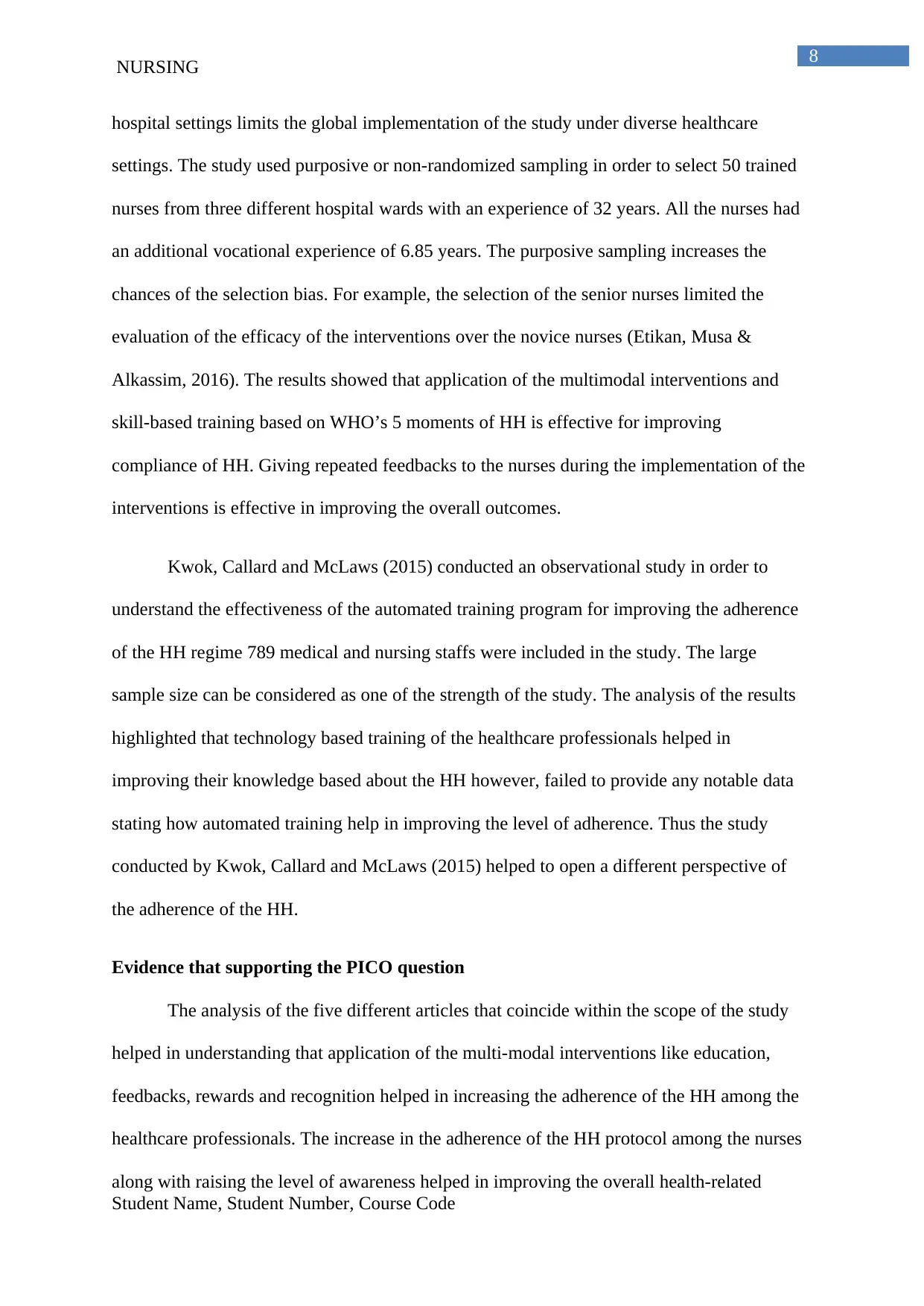
8
NURSING
hospital settings limits the global implementation of the study under diverse healthcare
settings. The study used purposive or non-randomized sampling in order to select 50 trained
nurses from three different hospital wards with an experience of 32 years. All the nurses had
an additional vocational experience of 6.85 years. The purposive sampling increases the
chances of the selection bias. For example, the selection of the senior nurses limited the
evaluation of the efficacy of the interventions over the novice nurses (Etikan, Musa &
Alkassim, 2016). The results showed that application of the multimodal interventions and
skill-based training based on WHO’s 5 moments of HH is effective for improving
compliance of HH. Giving repeated feedbacks to the nurses during the implementation of the
interventions is effective in improving the overall outcomes.
Kwok, Callard and McLaws (2015) conducted an observational study in order to
understand the effectiveness of the automated training program for improving the adherence
of the HH regime 789 medical and nursing staffs were included in the study. The large
sample size can be considered as one of the strength of the study. The analysis of the results
highlighted that technology based training of the healthcare professionals helped in
improving their knowledge based about the HH however, failed to provide any notable data
stating how automated training help in improving the level of adherence. Thus the study
conducted by Kwok, Callard and McLaws (2015) helped to open a different perspective of
the adherence of the HH.
Evidence that supporting the PICO question
The analysis of the five different articles that coincide within the scope of the study
helped in understanding that application of the multi-modal interventions like education,
feedbacks, rewards and recognition helped in increasing the adherence of the HH among the
healthcare professionals. The increase in the adherence of the HH protocol among the nurses
along with raising the level of awareness helped in improving the overall health-related
Student Name, Student Number, Course Code
NURSING
hospital settings limits the global implementation of the study under diverse healthcare
settings. The study used purposive or non-randomized sampling in order to select 50 trained
nurses from three different hospital wards with an experience of 32 years. All the nurses had
an additional vocational experience of 6.85 years. The purposive sampling increases the
chances of the selection bias. For example, the selection of the senior nurses limited the
evaluation of the efficacy of the interventions over the novice nurses (Etikan, Musa &
Alkassim, 2016). The results showed that application of the multimodal interventions and
skill-based training based on WHO’s 5 moments of HH is effective for improving
compliance of HH. Giving repeated feedbacks to the nurses during the implementation of the
interventions is effective in improving the overall outcomes.
Kwok, Callard and McLaws (2015) conducted an observational study in order to
understand the effectiveness of the automated training program for improving the adherence
of the HH regime 789 medical and nursing staffs were included in the study. The large
sample size can be considered as one of the strength of the study. The analysis of the results
highlighted that technology based training of the healthcare professionals helped in
improving their knowledge based about the HH however, failed to provide any notable data
stating how automated training help in improving the level of adherence. Thus the study
conducted by Kwok, Callard and McLaws (2015) helped to open a different perspective of
the adherence of the HH.
Evidence that supporting the PICO question
The analysis of the five different articles that coincide within the scope of the study
helped in understanding that application of the multi-modal interventions like education,
feedbacks, rewards and recognition helped in increasing the adherence of the HH among the
healthcare professionals. The increase in the adherence of the HH protocol among the nurses
along with raising the level of awareness helped in improving the overall health-related
Student Name, Student Number, Course Code
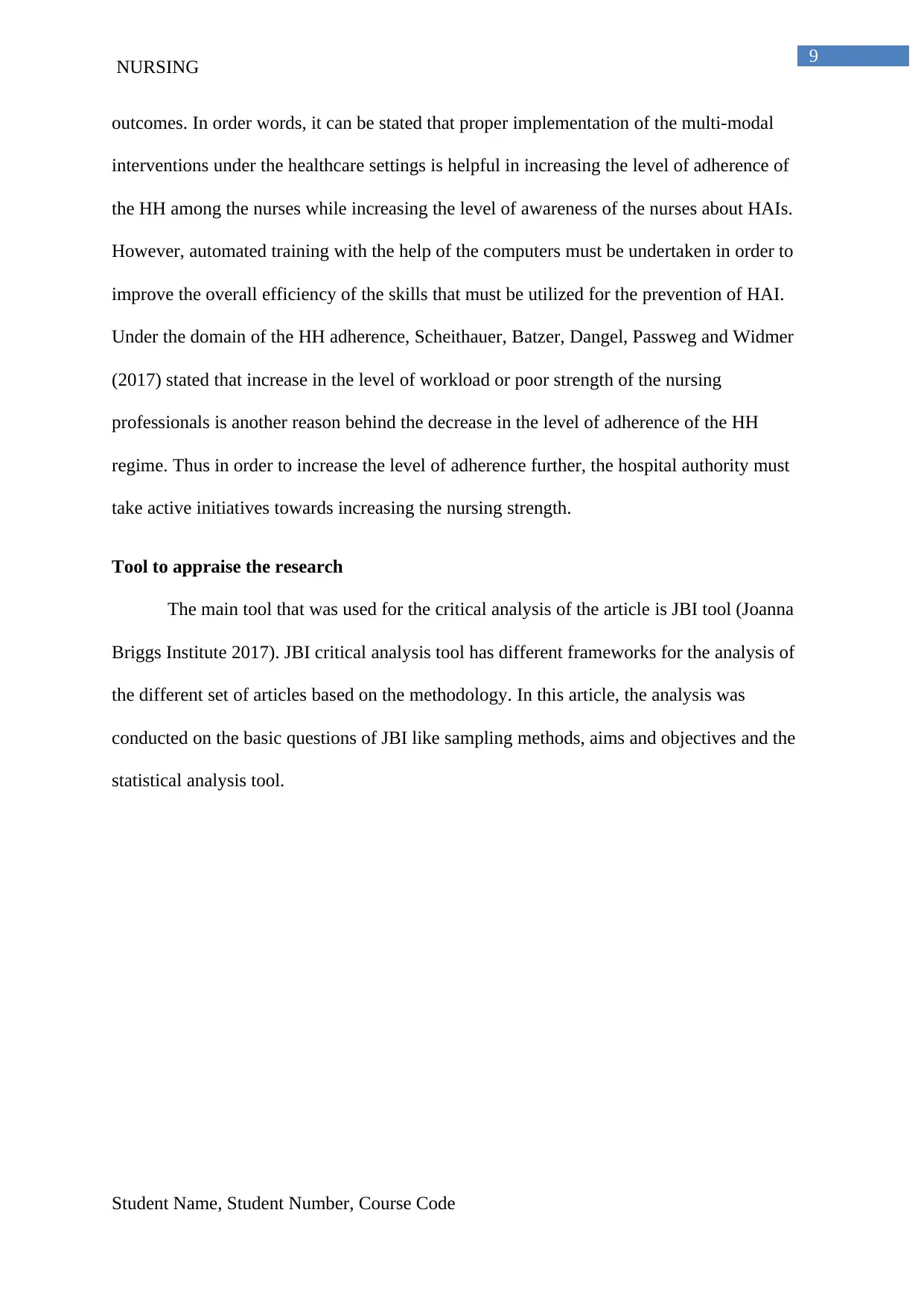
9
NURSING
outcomes. In order words, it can be stated that proper implementation of the multi-modal
interventions under the healthcare settings is helpful in increasing the level of adherence of
the HH among the nurses while increasing the level of awareness of the nurses about HAIs.
However, automated training with the help of the computers must be undertaken in order to
improve the overall efficiency of the skills that must be utilized for the prevention of HAI.
Under the domain of the HH adherence, Scheithauer, Batzer, Dangel, Passweg and Widmer
(2017) stated that increase in the level of workload or poor strength of the nursing
professionals is another reason behind the decrease in the level of adherence of the HH
regime. Thus in order to increase the level of adherence further, the hospital authority must
take active initiatives towards increasing the nursing strength.
Tool to appraise the research
The main tool that was used for the critical analysis of the article is JBI tool (Joanna
Briggs Institute 2017). JBI critical analysis tool has different frameworks for the analysis of
the different set of articles based on the methodology. In this article, the analysis was
conducted on the basic questions of JBI like sampling methods, aims and objectives and the
statistical analysis tool.
Student Name, Student Number, Course Code
NURSING
outcomes. In order words, it can be stated that proper implementation of the multi-modal
interventions under the healthcare settings is helpful in increasing the level of adherence of
the HH among the nurses while increasing the level of awareness of the nurses about HAIs.
However, automated training with the help of the computers must be undertaken in order to
improve the overall efficiency of the skills that must be utilized for the prevention of HAI.
Under the domain of the HH adherence, Scheithauer, Batzer, Dangel, Passweg and Widmer
(2017) stated that increase in the level of workload or poor strength of the nursing
professionals is another reason behind the decrease in the level of adherence of the HH
regime. Thus in order to increase the level of adherence further, the hospital authority must
take active initiatives towards increasing the nursing strength.
Tool to appraise the research
The main tool that was used for the critical analysis of the article is JBI tool (Joanna
Briggs Institute 2017). JBI critical analysis tool has different frameworks for the analysis of
the different set of articles based on the methodology. In this article, the analysis was
conducted on the basic questions of JBI like sampling methods, aims and objectives and the
statistical analysis tool.
Student Name, Student Number, Course Code
Secure Best Marks with AI Grader
Need help grading? Try our AI Grader for instant feedback on your assignments.
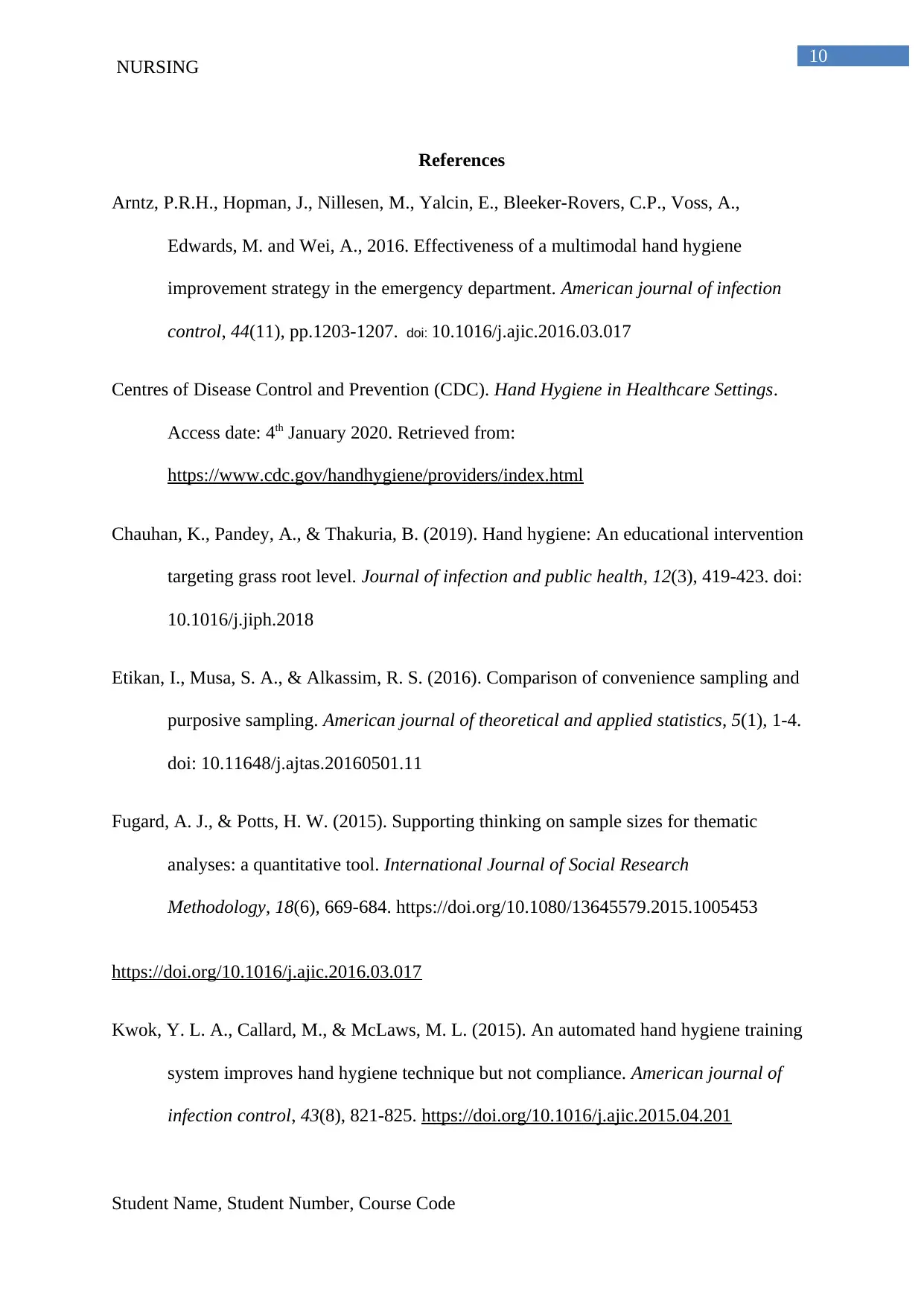
10
NURSING
References
Arntz, P.R.H., Hopman, J., Nillesen, M., Yalcin, E., Bleeker-Rovers, C.P., Voss, A.,
Edwards, M. and Wei, A., 2016. Effectiveness of a multimodal hand hygiene
improvement strategy in the emergency department. American journal of infection
control, 44(11), pp.1203-1207. doi: 10.1016/j.ajic.2016.03.017
Centres of Disease Control and Prevention (CDC). Hand Hygiene in Healthcare Settings.
Access date: 4th January 2020. Retrieved from:
https://www.cdc.gov/handhygiene/providers/index.html
Chauhan, K., Pandey, A., & Thakuria, B. (2019). Hand hygiene: An educational intervention
targeting grass root level. Journal of infection and public health, 12(3), 419-423. doi:
10.1016/j.jiph.2018
Etikan, I., Musa, S. A., & Alkassim, R. S. (2016). Comparison of convenience sampling and
purposive sampling. American journal of theoretical and applied statistics, 5(1), 1-4.
doi: 10.11648/j.ajtas.20160501.11
Fugard, A. J., & Potts, H. W. (2015). Supporting thinking on sample sizes for thematic
analyses: a quantitative tool. International Journal of Social Research
Methodology, 18(6), 669-684. https://doi.org/10.1080/13645579.2015.1005453
https://doi.org/10.1016/j.ajic.2016.03.017
Kwok, Y. L. A., Callard, M., & McLaws, M. L. (2015). An automated hand hygiene training
system improves hand hygiene technique but not compliance. American journal of
infection control, 43(8), 821-825. https://doi.org/10.1016/j.ajic.2015.04.201
Student Name, Student Number, Course Code
NURSING
References
Arntz, P.R.H., Hopman, J., Nillesen, M., Yalcin, E., Bleeker-Rovers, C.P., Voss, A.,
Edwards, M. and Wei, A., 2016. Effectiveness of a multimodal hand hygiene
improvement strategy in the emergency department. American journal of infection
control, 44(11), pp.1203-1207. doi: 10.1016/j.ajic.2016.03.017
Centres of Disease Control and Prevention (CDC). Hand Hygiene in Healthcare Settings.
Access date: 4th January 2020. Retrieved from:
https://www.cdc.gov/handhygiene/providers/index.html
Chauhan, K., Pandey, A., & Thakuria, B. (2019). Hand hygiene: An educational intervention
targeting grass root level. Journal of infection and public health, 12(3), 419-423. doi:
10.1016/j.jiph.2018
Etikan, I., Musa, S. A., & Alkassim, R. S. (2016). Comparison of convenience sampling and
purposive sampling. American journal of theoretical and applied statistics, 5(1), 1-4.
doi: 10.11648/j.ajtas.20160501.11
Fugard, A. J., & Potts, H. W. (2015). Supporting thinking on sample sizes for thematic
analyses: a quantitative tool. International Journal of Social Research
Methodology, 18(6), 669-684. https://doi.org/10.1080/13645579.2015.1005453
https://doi.org/10.1016/j.ajic.2016.03.017
Kwok, Y. L. A., Callard, M., & McLaws, M. L. (2015). An automated hand hygiene training
system improves hand hygiene technique but not compliance. American journal of
infection control, 43(8), 821-825. https://doi.org/10.1016/j.ajic.2015.04.201
Student Name, Student Number, Course Code
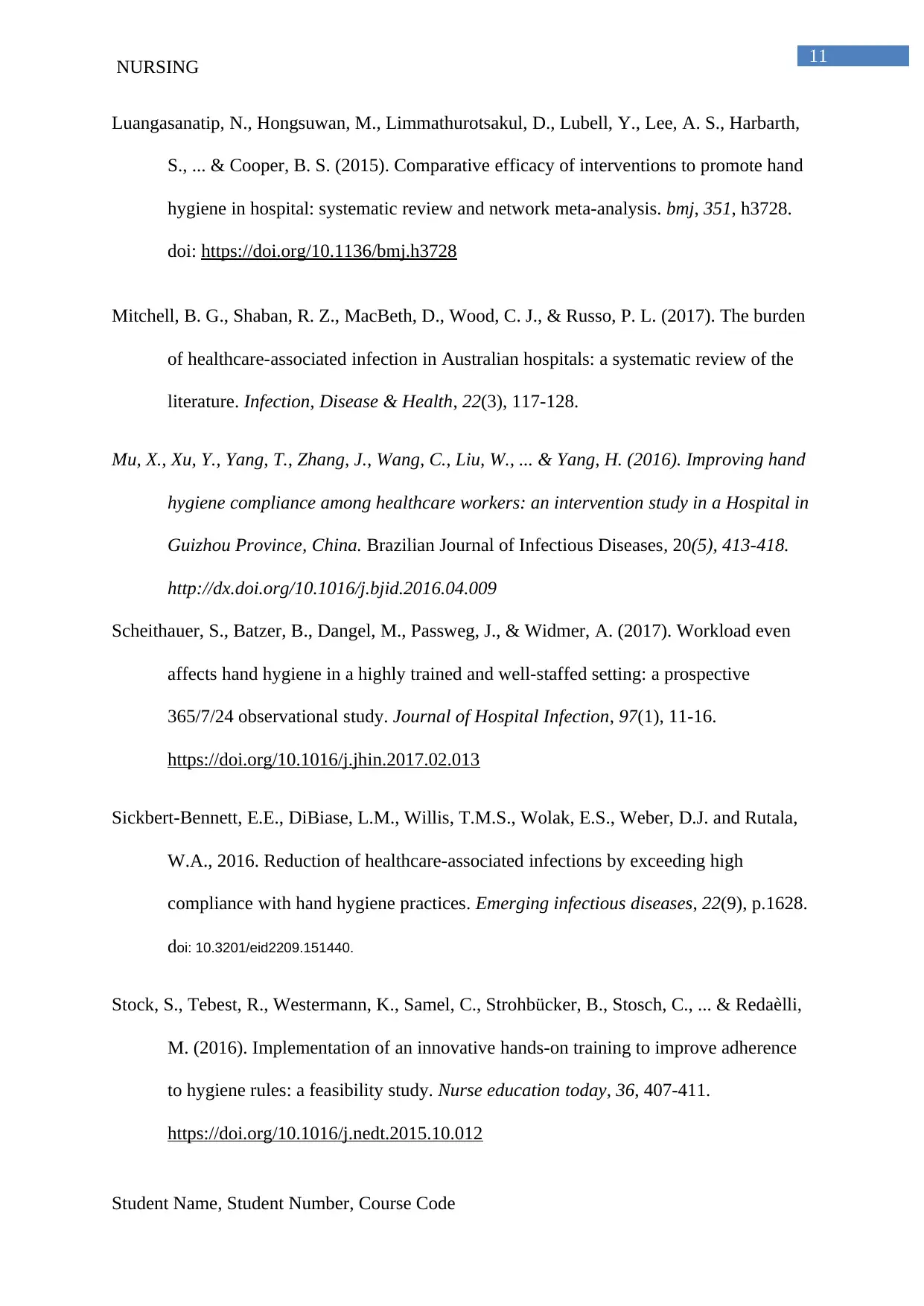
11
NURSING
Luangasanatip, N., Hongsuwan, M., Limmathurotsakul, D., Lubell, Y., Lee, A. S., Harbarth,
S., ... & Cooper, B. S. (2015). Comparative efficacy of interventions to promote hand
hygiene in hospital: systematic review and network meta-analysis. bmj, 351, h3728.
doi: https://doi.org/10.1136/bmj.h3728
Mitchell, B. G., Shaban, R. Z., MacBeth, D., Wood, C. J., & Russo, P. L. (2017). The burden
of healthcare-associated infection in Australian hospitals: a systematic review of the
literature. Infection, Disease & Health, 22(3), 117-128.
Mu, X., Xu, Y., Yang, T., Zhang, J., Wang, C., Liu, W., ... & Yang, H. (2016). Improving hand
hygiene compliance among healthcare workers: an intervention study in a Hospital in
Guizhou Province, China. Brazilian Journal of Infectious Diseases, 20(5), 413-418.
http://dx.doi.org/10.1016/j.bjid.2016.04.009
Scheithauer, S., Batzer, B., Dangel, M., Passweg, J., & Widmer, A. (2017). Workload even
affects hand hygiene in a highly trained and well-staffed setting: a prospective
365/7/24 observational study. Journal of Hospital Infection, 97(1), 11-16.
https://doi.org/10.1016/j.jhin.2017.02.013
Sickbert-Bennett, E.E., DiBiase, L.M., Willis, T.M.S., Wolak, E.S., Weber, D.J. and Rutala,
W.A., 2016. Reduction of healthcare-associated infections by exceeding high
compliance with hand hygiene practices. Emerging infectious diseases, 22(9), p.1628.
doi: 10.3201/eid2209.151440.
Stock, S., Tebest, R., Westermann, K., Samel, C., Strohbücker, B., Stosch, C., ... & Redaèlli,
M. (2016). Implementation of an innovative hands-on training to improve adherence
to hygiene rules: a feasibility study. Nurse education today, 36, 407-411.
https://doi.org/10.1016/j.nedt.2015.10.012
Student Name, Student Number, Course Code
NURSING
Luangasanatip, N., Hongsuwan, M., Limmathurotsakul, D., Lubell, Y., Lee, A. S., Harbarth,
S., ... & Cooper, B. S. (2015). Comparative efficacy of interventions to promote hand
hygiene in hospital: systematic review and network meta-analysis. bmj, 351, h3728.
doi: https://doi.org/10.1136/bmj.h3728
Mitchell, B. G., Shaban, R. Z., MacBeth, D., Wood, C. J., & Russo, P. L. (2017). The burden
of healthcare-associated infection in Australian hospitals: a systematic review of the
literature. Infection, Disease & Health, 22(3), 117-128.
Mu, X., Xu, Y., Yang, T., Zhang, J., Wang, C., Liu, W., ... & Yang, H. (2016). Improving hand
hygiene compliance among healthcare workers: an intervention study in a Hospital in
Guizhou Province, China. Brazilian Journal of Infectious Diseases, 20(5), 413-418.
http://dx.doi.org/10.1016/j.bjid.2016.04.009
Scheithauer, S., Batzer, B., Dangel, M., Passweg, J., & Widmer, A. (2017). Workload even
affects hand hygiene in a highly trained and well-staffed setting: a prospective
365/7/24 observational study. Journal of Hospital Infection, 97(1), 11-16.
https://doi.org/10.1016/j.jhin.2017.02.013
Sickbert-Bennett, E.E., DiBiase, L.M., Willis, T.M.S., Wolak, E.S., Weber, D.J. and Rutala,
W.A., 2016. Reduction of healthcare-associated infections by exceeding high
compliance with hand hygiene practices. Emerging infectious diseases, 22(9), p.1628.
doi: 10.3201/eid2209.151440.
Stock, S., Tebest, R., Westermann, K., Samel, C., Strohbücker, B., Stosch, C., ... & Redaèlli,
M. (2016). Implementation of an innovative hands-on training to improve adherence
to hygiene rules: a feasibility study. Nurse education today, 36, 407-411.
https://doi.org/10.1016/j.nedt.2015.10.012
Student Name, Student Number, Course Code
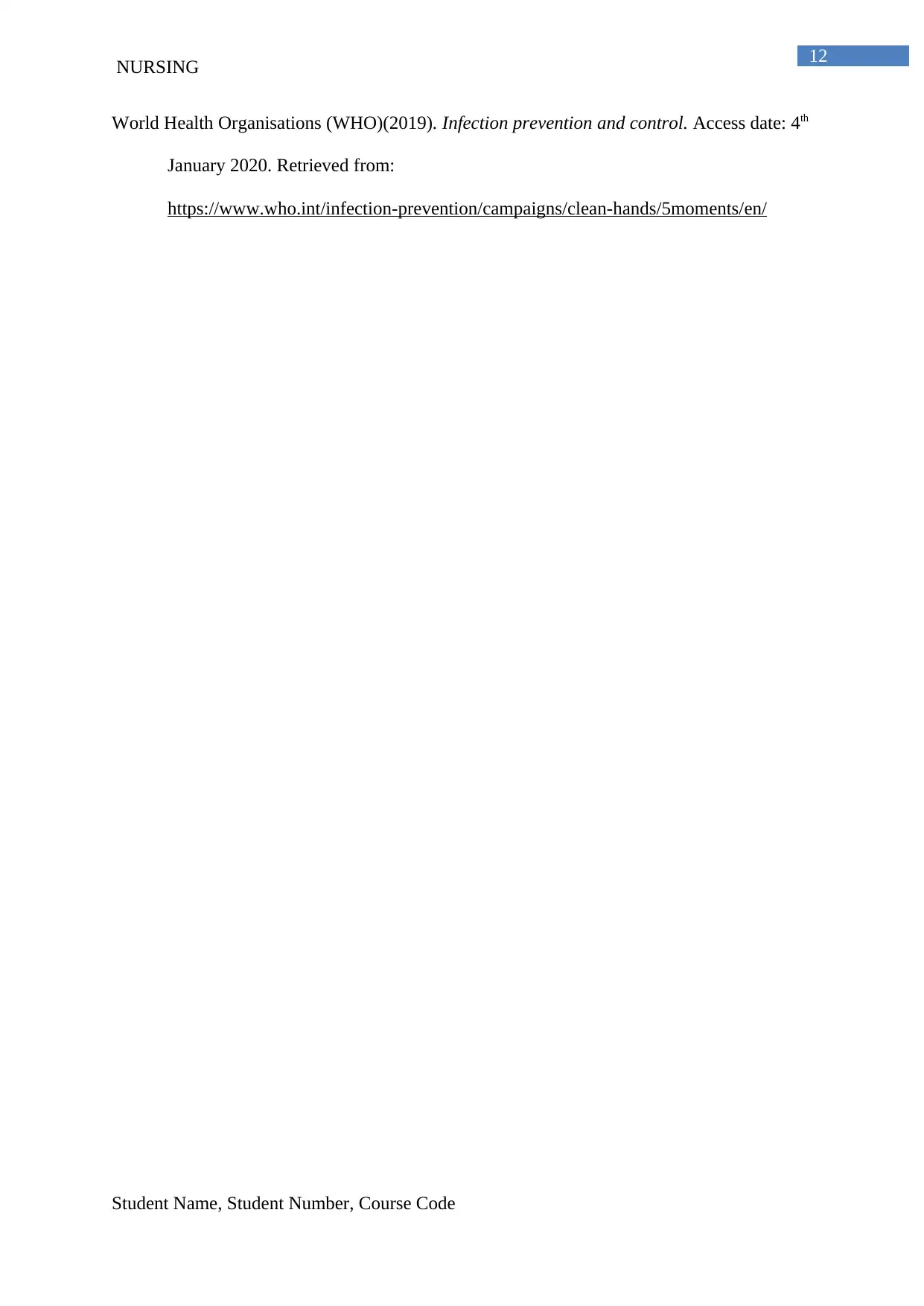
12
NURSING
World Health Organisations (WHO)(2019). Infection prevention and control. Access date: 4th
January 2020. Retrieved from:
https://www.who.int/infection-prevention/campaigns/clean-hands/5moments/en/
Student Name, Student Number, Course Code
NURSING
World Health Organisations (WHO)(2019). Infection prevention and control. Access date: 4th
January 2020. Retrieved from:
https://www.who.int/infection-prevention/campaigns/clean-hands/5moments/en/
Student Name, Student Number, Course Code
1 out of 13
Related Documents
Your All-in-One AI-Powered Toolkit for Academic Success.
+13062052269
info@desklib.com
Available 24*7 on WhatsApp / Email
![[object Object]](/_next/static/media/star-bottom.7253800d.svg)
Unlock your academic potential
© 2024 | Zucol Services PVT LTD | All rights reserved.





